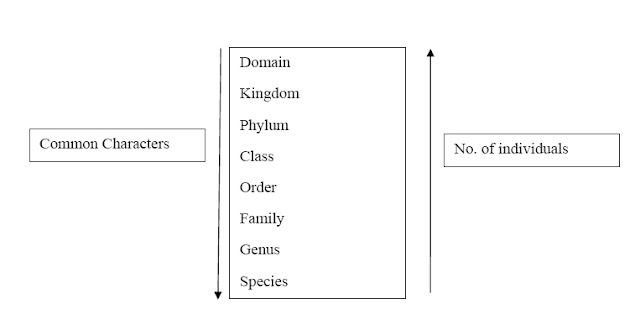The early classification systems were all artificial
systems. Mostly based on human uses.
Aristotle was the first to classify organisms scientifically. He divided
organisms into plants and
animals. Animals were further classified according to criteria such as
mode of locomotion,
reproduction and presence or absence of red blood cells. Aristotle’s
pupil Theophrastu
classified plants according to habit e.g. Trees, Shrubs and herbs, and
according to lifespan e.g
annuals, biennials and perennials.Up to
the time of Linnaeus scientists used many different methods.
Carolus Linnaeus(1753), Swedish botanist, introduced binomial
nomenclature and classified
about
6000 plants into a hierarchical order of taxa.;
Species, genus, order, and class.
His
classification of flowering plants was based on the number of stamens
and styles of flower. He
identified two kingdoms of organisms; plants and animals.With
the discovery of microorganisms the scientists understood that there were
organisms
which
could not be assigned into either plants or animals. To get over this
difficulty Ernest
Haeckel (1866) introduced a third kingdom: Protista. He also introduced
the taxon Phylum and
classified many organisms.
With
the discovery of electron microscope biologists identified prokaryotic and
eukaryotic
cellular organization . Robert H Whittaker (1969) introduced five
kingdom system of
biological classification; Monera, Protista, Fungi, Plantae and Animalia.
His classification was based
on nature of cellular organization, unicellular or multicellular nature and
mode of
nutrition.
With
the acceptance of Darwin’s theory on evolution and unitary origin of life,
taxonomists
began
to use natural systems. With recent advancement of molecular biology and the
use of
molecular methods in studying evolutionary relationships it became
apparent that in the very
early
evolution, organisms had separated into three stocks which are now called
Domains. Carl
Woese
(1977) classified organisms into three Domains Archaea, Bacteria and Eukarya at
a
higher level over Kingdom
Hierarchy of Taxa from Domains to Species.
In
taxonomy each level of taxonomical hierarchy is called a taxon (plural-taxa)
and each taxon
has a
rank and a name.
E.g.: Class: Reptilia
Under
the hierarchical system there are levels of taxa. Each Domain is divided into
kingdoms.
Kingdom is divided into phyla (singular phylum), phylum into classes
.etc. Many of these
categories may also be subdivided.
E.g.: Sub-family, Subspecies etc.
From
domain to species, the number of shared characters among the members in the
taxa
decreases. From species to domain, the number of individuals in the
taxon increases.
Present System of Classification and its basis
With
the rapid advance of molecular biology new information on the evolutionary
relationships of organisms are being collected rapidly. The sequence of
bases of DNA of
important genes, DNA of mitochondria, the base sequence of ribosomal RNA, the sequence
of
amino acids in common proteins, molecular structure of cellular components are
used as
important taxonomic criteria in modern systematics. As a result
classification systems are
changing rapidly.
We
adopt here the three domain classification suggested by Woese for convenience.
It is very
clear however that the kingdom Protista is not a natural group. It is an
artificial group
including organisms which have different evolutionary origins. Viruses
do not have cellular
organization, therefore does not belong to any of the kingdoms. It is
also an artificial group
considered separately.
Domain – Bacteria
Domain - Archaea
Domain - Eukarya
Kingdom
– Protista
Fungi
P
la n ta e
Animalia
Domains
Domain : Bacteria
• Cellular organization
prokaryotic
• Cell wall component peptidoglycan.
• Lipids in cell membrane are
not branched.
• Sensitive to antibiotics.
• Protein synthesis begins with
formyl methionine.
• One kind of RNA polymerase
enzyme.
• Lives in many habitats.
•
Eg: Cyanobacteria, Purple bacteria, Green sulphur bacteria
Domain : Archaea
• Cellular organization
prokaryotic
• Cell wall component lacks
peptidoglycan, contains proteins and polysaccharides.
• Lipids in cell membrane have
branched and chained structure.
• Not sensitive to antibiotics
like streptomycin and chloramphenicol(like eukaryotes)
• Protein synthesis begins with
methionine (like in eukaryotes)
• Several kinds of RNA
polymerase enzymes (like in eukaryotes)
• Lives in extreme
environmental conditions such as volcanic pits, hot springs, salt
marshes, deep-sea etc.
• Eg: Methanococcus, Thermococcus
Methanobacterium, Halobacterium
Domain Eukarya
•
Cellular organization eukaryotic
• Cell wall component lacks
peptidoglycan, contains polysaccharides.
• Lipids in cell membrane are
not branched.
• Not sensitive to antibiotics.
• Protein synthesis begins with
methionine.
• Several kinds of RNA
polymerase enzymes.
• Lives in many different
environmental conditions.
• E.g. protists, fungi, plants
and animals.
• Viruses -
Discuss the common characteristics of viruses




No comments:
Post a Comment